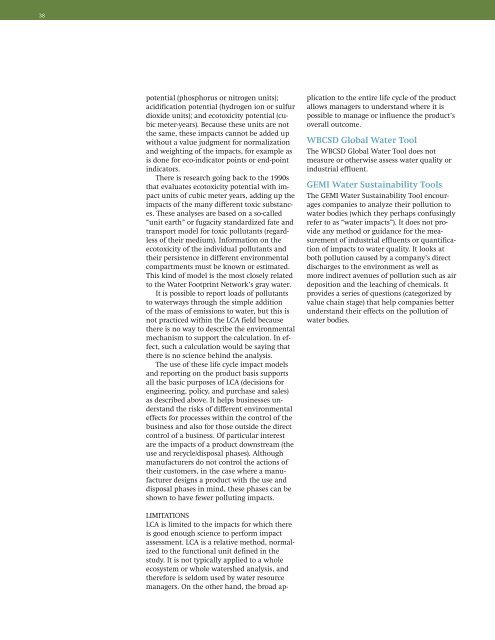Corporate Water Accounting: An Analysis of Methods and Tools for ...
Corporate Water Accounting: An Analysis of Methods and Tools for ...
Corporate Water Accounting: An Analysis of Methods and Tools for ...
You also want an ePaper? Increase the reach of your titles
YUMPU automatically turns print PDFs into web optimized ePapers that Google loves.
38<br />
potential (phosphorus or nitrogen units);<br />
acidification potential (hydrogen ion or sulfur<br />
dioxide units); <strong>and</strong> ecotoxicity potential (cubic<br />
meter-years). Because these units are not<br />
the same, these impacts cannot be added up<br />
without a value judgment <strong>for</strong> normalization<br />
<strong>and</strong> weighting <strong>of</strong> the impacts, <strong>for</strong> example as<br />
is done <strong>for</strong> eco-indicator points or end-point<br />
indicators.<br />
There is research going back to the 1990s<br />
that evaluates ecotoxicity potential with impact<br />
units <strong>of</strong> cubic meter years, adding up the<br />
impacts <strong>of</strong> the many different toxic substances.<br />
These analyses are based on a so-called<br />
“unit earth” or fugacity st<strong>and</strong>ardized fate <strong>and</strong><br />
transport model <strong>for</strong> toxic pollutants (regardless<br />
<strong>of</strong> their medium). In<strong>for</strong>mation on the<br />
ecotoxicity <strong>of</strong> the individual pollutants <strong>and</strong><br />
their persistence in different environmental<br />
compartments must be known or estimated.<br />
This kind <strong>of</strong> model is the most closely related<br />
to the <strong>Water</strong> Footprint Network’s gray water.<br />
It is possible to report loads <strong>of</strong> pollutants<br />
to waterways through the simple addition<br />
<strong>of</strong> the mass <strong>of</strong> emissions to water, but this is<br />
not practiced within the LCA field because<br />
there is no way to describe the environmental<br />
mechanism to support the calculation. In effect,<br />
such a calculation would be saying that<br />
there is no science behind the analysis.<br />
The use <strong>of</strong> these life cycle impact models<br />
<strong>and</strong> reporting on the product basis supports<br />
all the basic purposes <strong>of</strong> LCA (decisions <strong>for</strong><br />
engineering, policy, <strong>and</strong> purchase <strong>and</strong> sales)<br />
as described above. It helps businesses underst<strong>and</strong><br />
the risks <strong>of</strong> different environmental<br />
effects <strong>for</strong> processes within the control <strong>of</strong> the<br />
business <strong>and</strong> also <strong>for</strong> those outside the direct<br />
control <strong>of</strong> a business. Of particular interest<br />
are the impacts <strong>of</strong> a product downstream (the<br />
use <strong>and</strong> recycle/disposal phases). Although<br />
manufacturers do not control the actions <strong>of</strong><br />
their customers, in the case where a manufacturer<br />
designs a product with the use <strong>and</strong><br />
disposal phases in mind, these phases can be<br />
shown to have fewer polluting impacts.<br />
Limitations<br />
LCA is limited to the impacts <strong>for</strong> which there<br />
is good enough science to per<strong>for</strong>m impact<br />
assessment. LCA is a relative method, normalized<br />
to the functional unit defined in the<br />
study. It is not typically applied to a whole<br />
ecosystem or whole watershed analysis, <strong>and</strong><br />
there<strong>for</strong>e is seldom used by water resource<br />
managers. On the other h<strong>and</strong>, the broad application<br />
to the entire life cycle <strong>of</strong> the product<br />
allows managers to underst<strong>and</strong> where it is<br />
possible to manage or influence the product’s<br />
overall outcome.<br />
WBCSD Global <strong>Water</strong> Tool<br />
The WBCSD Global <strong>Water</strong> Tool does not<br />
measure or otherwise assess water quality or<br />
industrial effluent.<br />
GEMI <strong>Water</strong> Sustainability <strong>Tools</strong><br />
The GEMI <strong>Water</strong> Sustainability Tool encourages<br />
companies to analyze their pollution to<br />
water bodies (which they perhaps confusingly<br />
refer to as “water impacts”). It does not provide<br />
any method or guidance <strong>for</strong> the measurement<br />
<strong>of</strong> industrial effluents or quantification<br />
<strong>of</strong> impacts to water quality. It looks at<br />
both pollution caused by a company’s direct<br />
discharges to the environment as well as<br />
more indirect avenues <strong>of</strong> pollution such as air<br />
deposition <strong>and</strong> the leaching <strong>of</strong> chemicals. It<br />
provides a series <strong>of</strong> questions (categorized by<br />
value chain stage) that help companies better<br />
underst<strong>and</strong> their effects on the pollution <strong>of</strong><br />
water bodies.
















